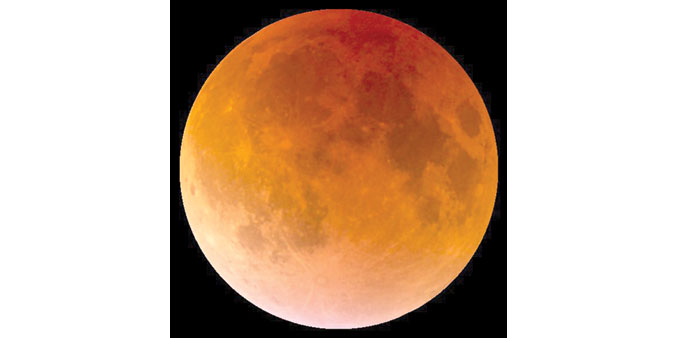By Steff Gaulter
If you were awake in the early hours of Monday morning and looked up at the sky, you may have seen a dramatic sight. Our moon looked strangely large and was lit up an eerie red colour. This mysterious spectacle was created by the intricate way that the sun, the earth and the moon all travel around each other.
A huge red moon, such as the one seen on Sunday night, is called a supermoon lunar eclipse. It’s the combination of three things happening at the same time: the moon passing close to the earth, a full moon and an eclipse. Individually, none of the events are particularly unusual, but it is far more rare when they all happen at the same time.
It may surprise you to hear that the moon isn’t always the same distance away from the Earth. Its path is elliptical, rather than a perfect circle. At its closest point the centre of the moon is 363,396km (225,804 miles) from the centre of the earth, whereas at its furthest it is 405,504km (251,968 miles). Most of the time, we don’t even notice how far the moon is away from us, but there a few times when it becomes more obvious.
The moon reaches its point closest to the earth just under once a month. If you live near the ocean, you may notice that the tides are higher than usual at these times. However, no matter where you live, the size of a moon can give away how far it is away from the Earth, especially if its closest point coincides with a full moon.
The apparent increase in size of the full moon when it is at its closest point to Earth led to it being known as a supermoon. The opposite, when a full moon occurs when the moon is at its further point from the Earth, is known as a micro moon. For those of you thinking that a supermoon doesn’t sound particularly scientific, you’d be right. The technical term is perigee-syzygy, which is certainly not as catchy. Whatever you choose to call it, the large full moon looks about 7% bigger than an average full moon, or 14% larger than a micro moon and 30% brighter.
The huge moon that was visible on the night of September 27 was a supermoon. This explains its size and brightness. However, its red tinge is due to something else entirely. The colour was due to a lunar eclipse.
In order for us to see a full moon, the sun has to be shining from behind the earth onto the moon. This means the earth has to be in between the sun and the moon. Normally the three bodies don’t line up exactly, and we see the moon fully illuminated. However, on certain occasions they do line up perfectly, allowing the moon to move into the shadow of the Earth. This plunges the moon into the darkness we call a lunar eclipse.
When the moon is in the shadow of the Earth, however, the moon isn’t completely black. This isn’t too much of a surprise, given that when we look at our own shadow on the pavement, it’s not completely black either. However, unlike our shadows, the light on the moon during a lunar eclipse has a reddish colour.
The red hue is due to the Earth’s atmosphere. Our atmosphere only extends 80 kilometres (50 miles) above the Earth’s surface, but this tiny slither of air allows us to breathe, creates our weather and even dictates the colour of a lunar eclipse.
You probably remember from science at school that white light is made up of light of all the colours of the rainbow. As the sun’s rays hit our atmosphere, some of the light is separated into the individual colours. The different colours are scattered different amounts; purples and blues are scattered most, which is why the sky is blue, and red is scattered least, which is why sunsets are red.
When the sun shines directly overhead, the sunlight passes through as little of our atmosphere as possible. However, when the sun sets and it is close to the horizon, it passes through a greater portion of the atmosphere. This allows more light to be scattered, and leaves only the red shades.
A similar process happens during a lunar eclipse. The sun’s rays are blocked by the Earth, but they can still pass around the edges, through the slither of our atmosphere. The atmosphere scatters the light, but as red is scattered least, this is the colour that we see on the moon. Interestingly, the more pollution there is in the air, the more scattering takes place and the redder the moon will appear. This means you can never be sure exactly how red the moon will be.
For those of you who missed the spectacle, and are now keen to see a huge red moon, then I’m sorry to say that we have a bit of a wait before we can see another one. The next supermoon lunar eclipse isn’t scheduled until 8 October 2033, and I’m not sure my diary quite extends that far!

The supermoon lunar eclipse that happened on September 27. Photo by Alfredo Garcia Jr/Wikipedia
